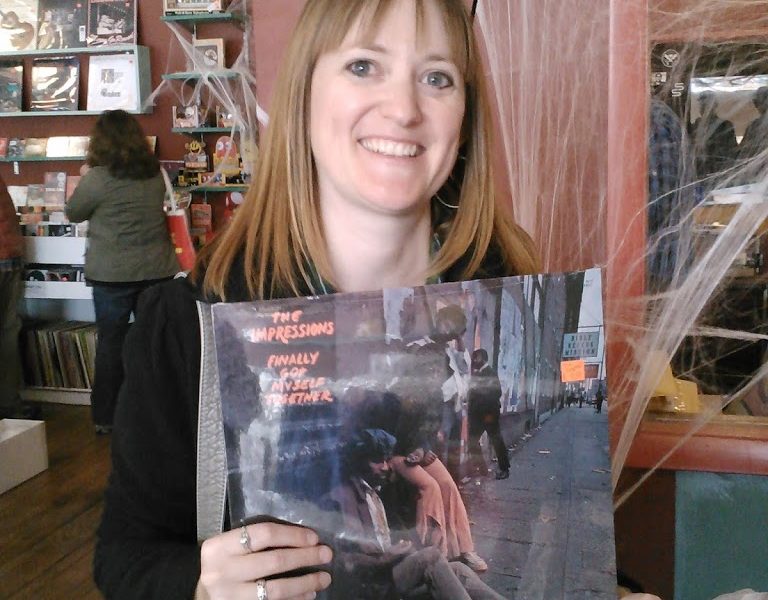
CIW Co-op Members Explore and Brainstorm During Night at the Museum
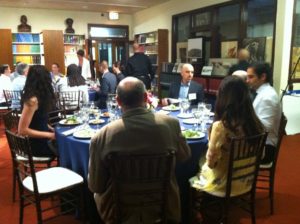 |
| Chicago Ideas Week (CIW) staff and Co-op members brainstorm over dinner at The Field Museum on Tuesday. |
Ever wonder what goes on at The Field Museum after dark, when the doors are closed and the lights are dimmed?
Well, Sue the T-Rex doesn’t come alive – but great ideas do.
On Tuesday night, a group of about 10 people from Chicago Ideas Week (CIW) and the CIW Co-op saw the amazing research happening at the museum and brainstormed new ways to communicate that knowledge with Chicago and the rest of the world.
“We have this great group of leaders within the city and the Co-op,” said Kelly Hagler, CIW’s program and community manager. “Why not utilize them and their expertise to help the museum find new, innovative ideas to reach the community and really share its awesome story?”
In the vein of sparking innovation, CIW and The Field Museum hand-picked a group of leaders from diverse backgrounds to attend. Among them were Amy Cheronis, executive vice president at Leo Burnett; Phil Tadros, co-founder and CEO of Doejo and Bow Truss Coffee Roastersand Brad Keywell, CIW’s founder.
“The essence of the Co-op is that everybody comes from a different background,” Hagler said. “We picked people that maybe The Field Museum wouldn’t have access to, or just wouldn’t think about going to.”
The night started with a behind-the-scenes tour of the museum’s secret third floor. Along labyrinth-like corridors decorated with maps and animal renderings on the walls, the group of storytellers, entrepreneurs and tech geeks split in two teams and explored the museum’s research arm.
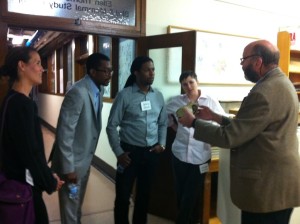 |
| Zoologist Bill Stanley shows the group a seal skull. |
Bill Stanley, the museum’s mammals collection manager, explained the process of making animal specimens and wowed the groups as he drew three flying squirrel specimens from a drawer in a Russian-doll sequence. He then showed them one of the museum’s rare collections: the world’s only specimen of kipunji, a new species of monkey discovered in Tanzania in 2004.
With more than 200,000 specimens in its mammals collection alone, public exhibits like Sue represent only 1 percent of The Field’s overall collections – which draw researchers from around the globe, Stanley said.
“Scientists from all over the world come to us on a daily basis to figure out our past, what’s going on right now and what’s going to happen in the future,” he said.
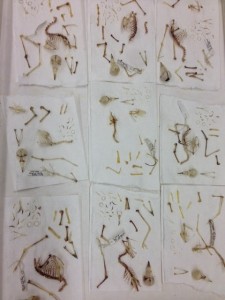 |
| The Field Museum has a massive bone collection. |
But the process behind scientific discoveries can be smelly, as Stanley led the groups to “the bug room,” which was filled with glass cases of beetles that feast on dead flesh. Zoologists use these beetles to clean up dead animals’ bones for making specimens, Stanley said, jokingly calling them “free labor.”
The sight sparked a debate on the best hiding place in a Night at the Museum scenario between Carrie Kennedy, CIW’s executive producer, and Maura Daley of the Clinton Health Access Initiative, as their team walked to the museum’s herbarium, the fifth largest in the Western Hemisphere.
Thorsten Lumbsch, the museum’s associate director of its integrative research center, explained that the museum is building a digital database of its 2.8 million plant specimens so that researchers can access them from anywhere on the planet. The database generated more than 10,000 online visitors last year, according to Charles Katzenmayer, the museum’s vice president for institutional advancement.
“It’s a global resource,” Katzenmayer said.
For many Co-op members, the 15-minute excursion opened a new window into the museum’s activities.
“That’s a once-in-a-lifetime experience,” said Daley as she and other members headed to the red-carpeted Marie Louise Rosenthal library for an intimate dinner discussion.
Over strawberry crumbles and chardonnay, the Co-op members and museum staffers brainstormed answers to the question that Richard Lariviere, the museum’s president, put on their plate:
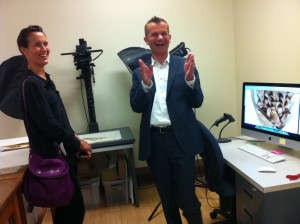 |
|||
| Botanist Thorston Lumbsch shows how they are digitizing specimens. |
How can The Field better communicate the power of the science happening here with the rest of the world?
Meg Robinson, the museum’s marketing director, said The Field has a bold goal: to expand its outreach fivefold and reach people on a global scale.
Online outreach would play a key role in reaching that goal, said Jimmy Odom, founder and CEO of WeDeliver, a startup running same-day delivery services in Chicago. Odom suggested that the museum build its brand as a voice of authority on science through social media and blog posts.
“Content creation is king,” said the 31-year-old. “There is so much content in these walls.”
Mike McGee, co-founder of the coding school The Starter League(TSL), said the museum needs to experiment with a combination of strategies to reach the general public as well as niche audiences like students and researchers.
“We all want the one magic solution…but sometimes you need to try 10 different approaches,” the 25-year-old said.
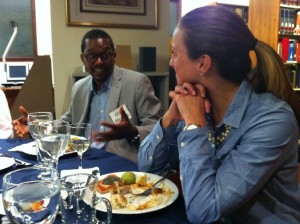 |
| Co-op member Mike McGee chats with the museum’s Meg Robinson. |
McGee also proposed a partnership between TSL and The Field, where TSL students can learn coding by making web apps that help the museum tell its stories.
“I would have loved to create apps for the Field Museum,” said Odom, a TSL alumnus.
While the digital world offers endless forms for sharing the museum’s stories, Kennedy said the emotional connection is what grabs the audience. She suggested producing a series of short videos featuring the scientists explaining their projects, or even debating with one another.
“There’s nothing more compelling than that insider perspective,” she said.
The conversation continued even as Lariviere called an end to the night.
“I have been inspired by this conversation,” he said. “It has given me a lot of terrific ideas and the courage to try new things.”
________________________
Written by: Jia You
Photography by: Jia You
Bone Photograph by: Jessica Malkin


